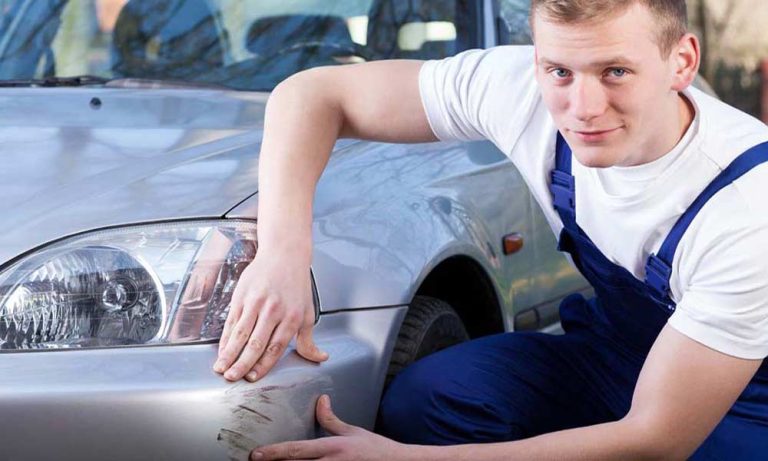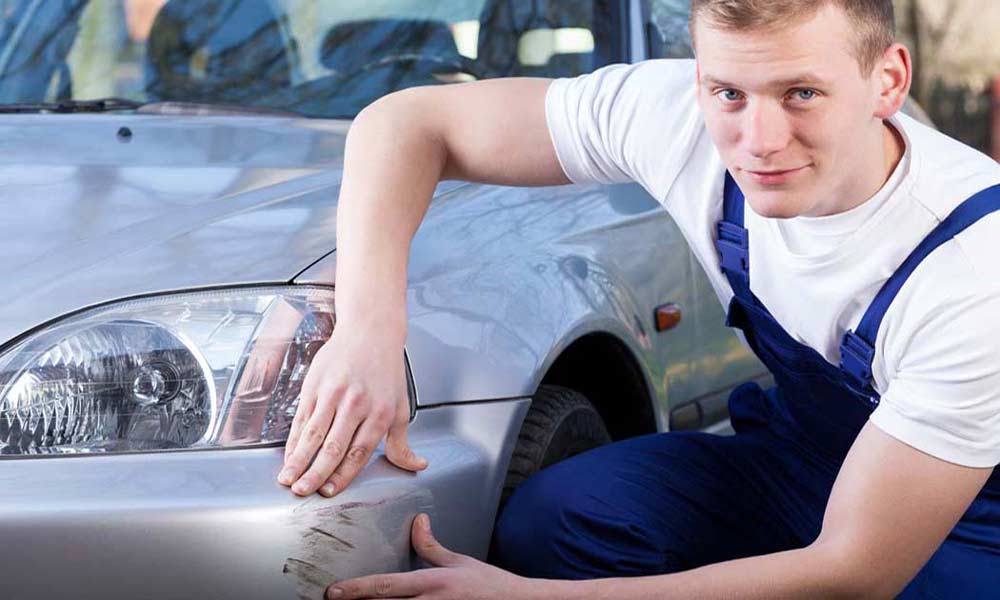
How to Stop Paint from Peeling Off Plastic Bumper?
We have all seen paint peeling off a plastic bumper. Whether the paint is just starting to get loose, or all of the paint has come loose and is hanging down, it’s a bad situation. The paint will begin to chip as soon as you begin driving around.
Initially, this small issue may not seem quite a big deal, but if you don’t take proper measures soon, it could result in a huge repair bill.

But how to stop paint from peeling off plastic bumper? In this guide, we will point out different reasons for this problem and how to solve it.
What Causes Paint to Peel on a Bumper?
When paint begins to peel on a bumper, it is usually the result of one of three things: poor adhesion, poor quality paint, or environmental factors.
Poor Adhesion
One of the most common reasons for the paint to peel on a bumper is poor adhesion. This can be caused by several things, including improper surface preparation, using the wrong type of primer, or applying the paint in humid or dusty conditions.
Poor Quality Paint
Another common reason for the paint to peel on a bumper is poor quality paint. This can be the result of using cheap paint, not allowing the paint to properly cure, or using paint that is not designed for use on a bumper.
Environmental Factors
Finally, environmental factors can also cause paint to peel on a bumper. This is most often seen in areas with high humidity or extreme temperatures, as these can cause the paint to expand and contract, leading to cracks and peeling. Also, UV rays can break down the protective barrier of your paint, causing it to fade and eventually peel away.
Also Read: Removing Paint from Chrome
How to Stop Paint from Peeling Off Plastic Bumper?
One very common issue with plastic bumpers is that the paint tends to peel off. Most car paint problems, including peeling, can be traced to improper preparation or painting techniques. When your painting starts to peel, it’s usually because the paint didn’t adhere properly to the metal surface.
To prevent your car’s paint from peeling, it’s important to regularly wash and wax the exterior. Avoid harsh chemicals on the surface of your car while washing, as these can strip away the protective layer of wax. This can lead to premature fading and peeling.
If your car was recently painted and the paint is already peeling, likely, the body shop didn’t follow proper procedure when they prepped and painted your car.
If you are determined to take this matter into your own hand and do the painting by yourself, follow our instructions for a better painting job.
What you need to collect before starting:
- Protective Goggles & Mask
- Safety Gloves
- Sanding Block or Sandpaper
- Paint Brush
- Primer for Plastic Surfaces
- Paint for Plastic Surfaces
- Spray Can or, Spray Gun
Now, let’s get into the job. Wear your protective goggles and mask to save your skin and eyes from paint fumes. They can be pretty irritating. So, take these necessary precautions before starting. Also, take your work in a ventilated area.
- First, use a sanding block or sandpaper to sand the surface of the bumper.
- Clean the desired surface. Use soapy water.
- Also, you can use denatured alcohol to remove any dust or debris.
- Next, apply a primer specifically designed for plastic surfaces using a paint brush. It helps the paint to cling and help it last longer.
- Let it completely dry before painting with your desired color of paint.
- As the primer is dry now, it is time to start painting.
- Choose a color that closely matches the original and apply it in thin coats until you’ve got full coverage.
- Use a spray can or spray gun to ensure an even coat of paint and avoid any drips.
- Allow the paint to completely dry.
- To safeguard the paintwork, apply a clear coat.
- Let the clear coat dry at least for 6 hours before driving your car.
Once you are done painting the bumper and ready to drive around, try to keep the bumper out of direct sunlight as much as possible. Also, try to avoid extra cold weather conditions. Doing these will help the paint stick with the bumper for a long time and not peel off.
Learn How to Fix Problems of a Plastic Bumper Cover:
Can You Repaint Plastic Bumpers?
If your car has plastic bumpers, you may be wondering if you can repaint them. The answer is, yes.
What kind of paint you use is important. You’ll need to use a plastic-specific paint that is made for automotive use. You can find this type of paint at most auto parts stores.
You’ll also need to sand the bumper before you paint it. Doing this, helps the new paint adjust with the surface better. Use sandpaper to sand the surface. Once you’ve sanded the bumper, you’re ready to paint. Follow our previously mentioned instructions.
With a little bit of effort and time, you can easily repaint your car’s plastic bumpers. Don’t forget to use the right type of paint.
Can You Repaint Part of a Bumper?
You can repaint a certain part of a bumper. But experts won’t recommend it. The reason for this is that it can be difficult to match the paint on the bumper. If you do decide to repaint part of the bumper, make sure to sand the area first and then use a primer before painting.
You can use spray paint if you want to get started quickly. You have to be careful, though. You have to make sure that the paint you use is compatible with the bumper and that you don’t go over the entire bumper in the process.
Continue Reading: Painting Flat Over Semi Gloss- Things You Need to Know
Can You Paint the Bumper without Removing It?
Of course, without taking the bumper off, you can paint it. But removing the bumper is the best way to paint it. Only in an emergency, without taking the bumper off, you can paint it.
Although painting the bumper attached will not get you the best job done, you can achieve a minimal painting solution. This is because if you remove the bumper from the car, your painting job will be more attractive and even.
If you are in a situation where you don’t have enough technical knowledge on how to remove the bumper, you can paint without removing it. Also, if there is only a small place that needs to be painted, you can ignore the removing hassle.
Just make sure to cover up the surroundings of the bumper and other open parts near the bumper like indicator lights or headlights. Otherwise, the spray can sit on them or you may end up spraying somewhere else.
Do You Need to Use Primer on Plastic Bumper?
When painting plastic bumpers, it is always best to use primer on them before painting. The reason for this is that primer provides a barrier between the paint and the plastic, which can help to prevent the paint from peeling or chipping over time.
In addition, primer can help to fill in any imperfections in the surface of the bumper, which will give you a smoother finish. If you are going to paint your bumper yourself, we recommend using a high-quality primer specifically designed for plastic surfaces.
How Much Does It Cost to Get a Plastic Bumper Painted?
Whether you are looking to touch up your car’s paint job or give it a complete makeover, the cost of painting a bumper can vary depending on several factors. The type of paint, the condition of the bumper, and whether you do it yourself or hire a professional; all play a role in how much money you will ultimately spend.
If you are planning to do it yourself, you can expect to spend around $80-$100 for supplies and equipment. However, if your bumper is in poor condition or you want a high-quality finish, it is best to hire a professional.
When considering the cost of painting your bumper, be sure about the time and effort required to achieve desired results. If you hire a professional, it could be more expensive. But this will save your time. For a low-end job with any professional, it may cost you around $200-$300.
For a high-end and premium painting, on average, it may cost you $50 to above $100. Remember that, these numbers are variable. Paint quality, painting space, and proper painting job vary in different professional paint shops.
What Paint Do You Use on Plastic Bumpers?
When it comes to painting plastic, it is important what paint you should use. Some paints will not stick to plastic, while others will adhere just fine. Acrylic paint works great for painting plastic. It’s available in both spray and brush-on varieties, and it adheres well to most types of plastic.
Another option is enamel paint, which also works well on plastic. It’s more durable than acrylic paint once it dries, so it’s a good choice for outdoor projects or items that will see a lot of wear and tear.
You can use a urethane-based paint, specifically a two-part urethane. A two-part urethane will give you the best durable finish that will resist fading and chipping. No matter what kind of paint you choose, make sure they are going to work for plastic surfaces.
Final Thoughts
If your paint is peeling off your plastic bumper, it could be a serious headache to tackle with. Many car owners face this problem. No matter what the cause, it is important to repair the problem as soon as possible to prevent further damage to the bumper.
Try to follow our instructions and advice to prevent this misery. If the situation gets out of hand, the best thing would be to contact a professional service.
